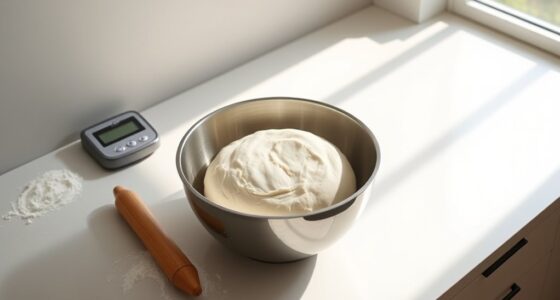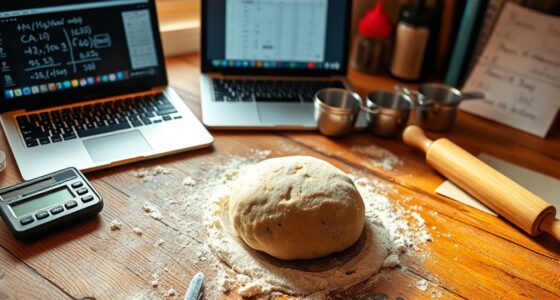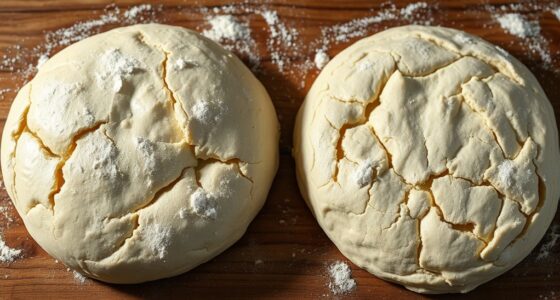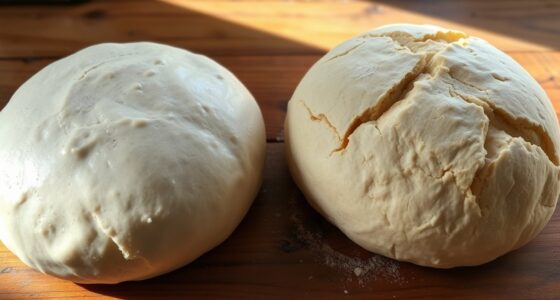To guarantee dough stays safe, understand how oil and sugar impact its preservation and structure. Oil creates a barrier that slows moisture loss and inhibits bacteria, while sugar fuels fermentation and affects dough texture. Too much of either can promote microbial growth or cause spoilage. Proper storage, moderation, and recipe adjustments are key to preventing issues. If you want to learn more about maintaining dough safety and quality, there’s plenty to explore ahead.
Key Takeaways
- Proper balance of oil and sugar prevents microbial growth and extends dough shelf life.
- Store dough in airtight containers and refrigerate to inhibit spoilage.
- Excessive sugar promotes bacteria, while too much oil can trap microbes, increasing spoilage risk.
- Signs of spoiled dough include off odors, mold, texture changes, and poor rise.
- Adjust ingredients carefully and avoid overuse to ensure dough safety and optimal baking results.
The Role of Oil in Dough Preservation
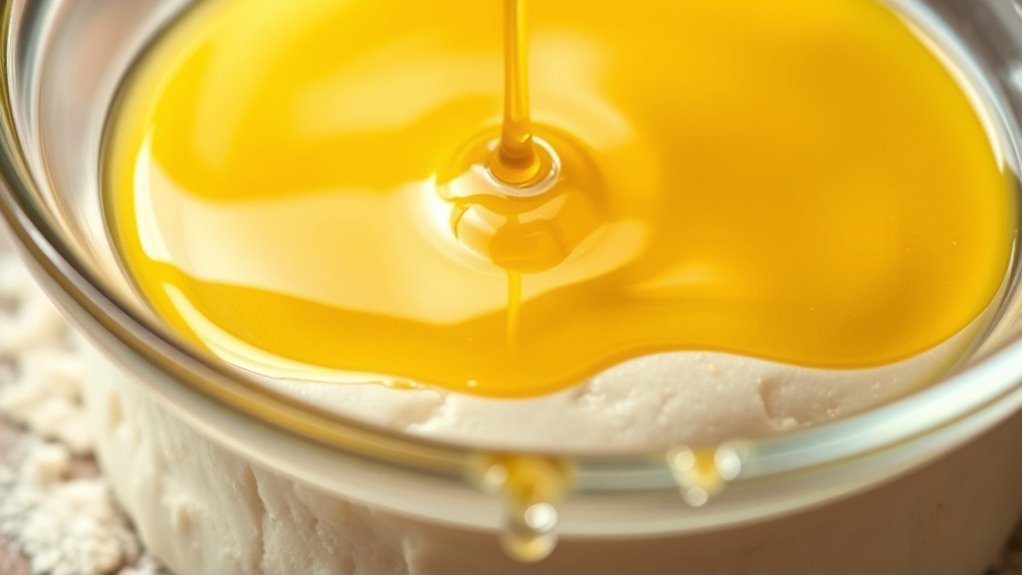
Oil plays a crucial role in preserving dough by creating a barrier that slows down moisture loss and inhibits bacterial growth. When you apply oil, its aroma can enhance the dough’s aroma profile, making baked goods more appealing. The oil forms a protective layer on the surface, reducing exposure to air and slowing sugar crystallization, which helps maintain dough texture and consistency. This barrier prevents the rapid drying out of dough, keeping it fresh longer. Additionally, the presence of oil can help prevent stickiness and improve handling. By controlling moisture and aroma, oil not only extends shelf life but also ensures your dough remains flavorful and easy to work with. Proper use of oil is essential for maintaining dough quality and safety during storage. Incorporating essential oils for preservation can further enhance the dough’s longevity and flavor profile.
How Sugar Affects Fermentation Processes

Sugar plays a vital role in fermentation by providing the yeast with a readily accessible source of energy. When you add sugar to dough, it fuels the sugar fermentation process, enabling yeast to produce carbon dioxide and alcohol. This gas creates the bubbles that make your bread rise, so controlling sugar levels is necessary for fermentation control. Too much sugar can weaken yeast activity, slowing fermentation or causing over-fermentation, which affects dough safety and quality. Conversely, too little sugar might result in insufficient gas production, leading to denser bread. Understanding how sugar affects fermentation helps you optimize dough rise and texture. Additionally, yeast activity can be influenced by sugar content, making it essential to monitor and adjust accordingly. By monitoring sugar content, you ensure a balanced fermentation process, yielding safe, well-leavened baked goods every time.
Impact of Oil and Sugar on Dough Texture and Structure

Oil creates a moisture barrier that helps keep dough tender and prevents it from drying out. Sugar’s crystallization can influence how the dough’s structure forms and affects its texture. Both ingredients impact how well your dough rises and its overall consistency during baking. Additionally, understanding how tuning modifications affect ingredient ratios can help in achieving optimal dough performance.
Oil’s Moisture Barrier
Because oils create a thin, protective layer on the dough’s surface, they help lock in moisture and prevent excessive drying during baking. This oil’s moisture barrier keeps the dough tender and ensures even baking. When incorporated properly, oil also enhances the dough’s structure by preventing it from becoming too crumbly. Sugar’s flavor enhancement works alongside this process, adding sweetness without compromising moisture. To understand their roles better: Top 15 options for convenience in outdoor settings.
Sugar’s Crystallization Effect
While oils form a protective barrier that keeps dough moist and tender, sugar influences its texture through crystallization. Sugar’s impact on dough comes from its crystallization effects, which can alter its smoothness and structure. When sugar dissolves, it can recrystallize during cooling or baking, creating a gritty or grainy texture. This process can weaken gluten networks, making the dough less elastic and more prone to breakage. If you add too much sugar or don’t control moisture levels, crystallization becomes more pronounced, affecting the final product’s quality. Recognizing sugar’s crystallization effects helps you prevent undesirable textures. Proper mixing, controlling temperature, and ingredient ratios ensure sugar’s impact remains beneficial rather than problematic in your dough. Additionally, understanding the crystallization process can help in adjusting recipes to achieve the desired dough consistency.
Texture and Rise Impact
The presence of oil and sugar considerably influences dough’s texture and its ability to rise properly. Oil adds moisture, making the dough more elastic, which improves dough elasticity and creates a tender crumb. It also prevents sticking and contributes to a softer texture. Sugar enhances flavor and interacts with gluten, slightly weakening the dough’s structure, which can impact how well it rises. Too much sugar may inhibit gluten development, leading to a denser loaf, while a moderate amount promotes a balanced rise. Additionally, sugar’s moisture helps maintain freshness. gluten development is affected by the amount of sugar, influencing the dough’s ability to form a strong network necessary for good rising. Overall, oil and sugar shape the dough’s texture, ensuring it’s both tender and flavorful, while supporting ideal rise. Adjusting their levels allows you to control the dough’s elasticity and final structure effectively.
Signs of Spoilage in Dough With Oil and Sugar

You should always trust your senses to spot spoilage in dough with oil and sugar. If it smells off or develops an unusual odor, that’s a red flag. Additionally, look for visible mold or any odd texture changes, like stickiness or dryness, to guarantee it’s still safe to use. Be aware that proper storage can help prevent spoilage and maintain dough quality for longer periods.
Off Odor Indicators
A noticeable off odor is one of the clearest signs that dough containing oil and sugar has spoiled. Odor detection is critical for identifying spoilage signs early. If your dough emits a rancid, sour, or pungent smell, it’s a strong indication that bacteria or mold have developed. Fresh dough typically has a neutral or slightly sweet aroma, so any deviation suggests spoilage. Trust your nose—if the smell is unusual or unpleasant, discard the dough immediately. Keep in mind that odors can sometimes be subtle, so frequent odor detection helps prevent consuming unsafe products. Recognizing these spoilage signs through smell ensures you avoid potential foodborne illnesses and maintain safe handling practices. Always err on the side of caution when your sense of smell alerts you to possible spoilage. Enhances customer interactions
Visible Mold Presence
Visible mold is a clear and alarming sign that dough containing oil and sugar has gone bad. Mold appears as fuzzy patches in various colors, often green, black, or white, on the dough’s surface. Even if artificial preservatives or flavor additives are present, mold indicates spoilage. Don’t ignore these signs, as mold can produce harmful toxins. Here’s what to watch for:
- Fuzzy or slimy spots on the dough
- Unusual discoloration or dark patches
- Wrinkled or dry surface with visible growth
- Persistent musty or sour smell accompanying mold
- Proper storage and handling can help prevent mold growth on dough.
Unusual Texture Changes
Unusual texture changes are strong indicators that dough with oil and sugar has spoiled. If the dough becomes sticky, overly dry, or develops a rubbery feel, it’s a sign that its dough elasticity has been compromised. These changes can affect how the dough behaves during baking, leading to poor rise or dense results. Spoiled dough may also develop a slimy or gritty texture, indicating bacterial or mold growth. Additionally, when the flavor enhancement diminishes or develops off-flavors, it’s a warning sign of spoilage. Trust your senses—if the texture feels abnormal or inconsistent with fresh dough, discard it. Proper storage and timely use are essential to maintaining both the texture and safety of dough with oil and sugar. Recognizing contrast ratio differences in texture can also help identify spoilage, especially when the dough’s appearance becomes uneven or mottled.
Proper Storage Techniques for Dough Containing Oil and Sugar
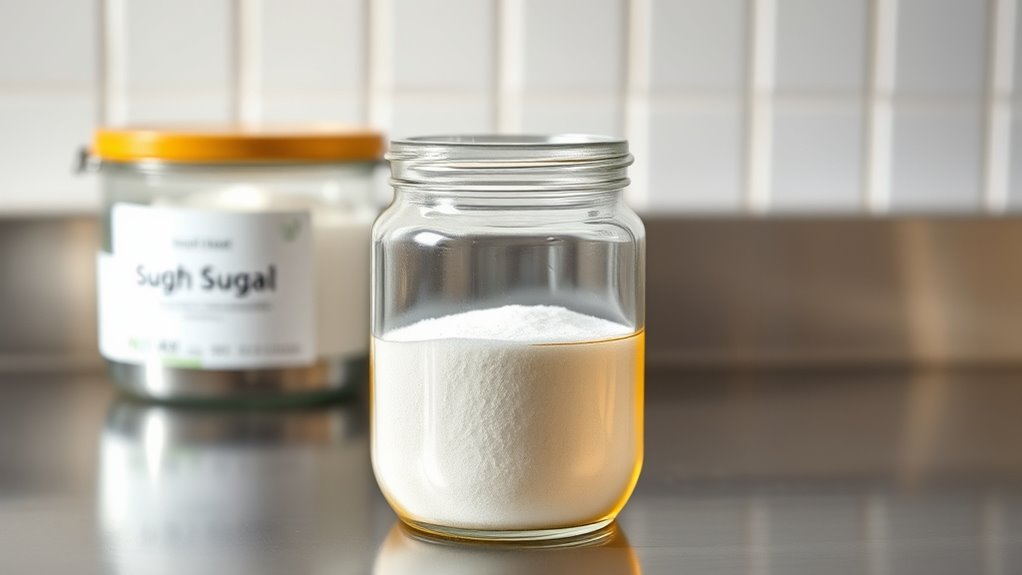
To keep dough containing oil and sugar fresh and safe to use, proper storage techniques are essential. You want to preserve dough flavor and ensure ingredient sourcing remains intact. Store your dough in an airtight container to prevent moisture loss and contamination. Keep it in the refrigerator at or below 40°F (4°C) to slow bacterial growth and maintain quality. Label containers with the date to track freshness. Avoid exposing the dough to direct sunlight or temperature fluctuations, which can affect ingredient stability. If you plan to store it long-term, consider freezing it, but wrap tightly to prevent freezer burn. Proper storage helps maintain the dough’s texture, flavor, and safety, ensuring your baking results remain consistent and delicious.
How Excessive Sugar Can Lead to Safety Concerns
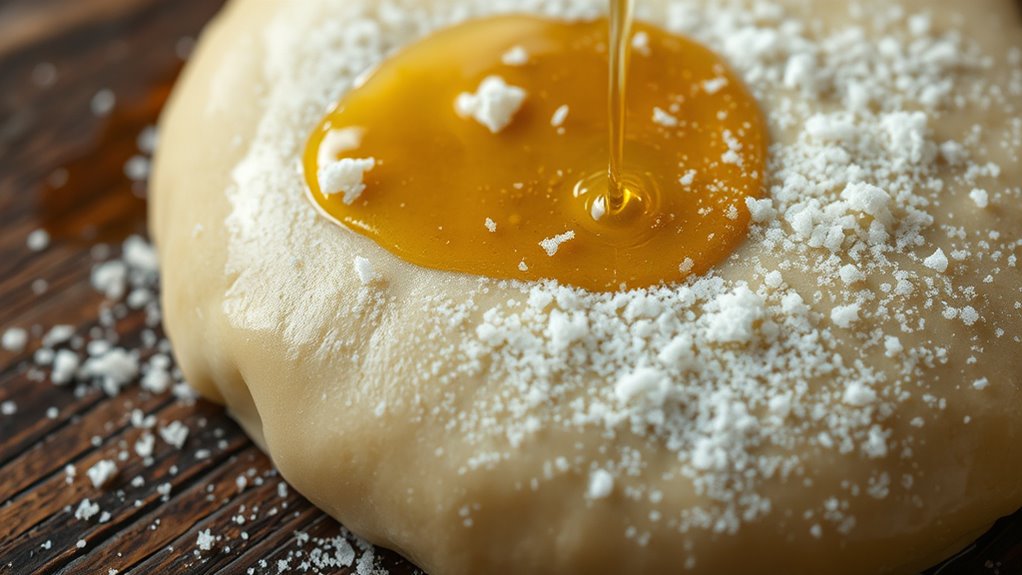
Excessive sugar in dough can pose serious safety risks by promoting the growth of harmful bacteria and molds. When you add too much sugar, it can create an environment that encourages microbial activity, increasing the chance of spoilage. To mitigate this, consider ingredient substitution—reducing sugar while maintaining flavor enhancement through natural alternatives like honey or fruit purees. These options can help balance sweetness without sacrificing safety. Over-sweetening not only affects the dough’s safety but can also impact dough stability and fermentation. By controlling sugar levels, you reduce the risk of unsafe bacterial proliferation and ensure your dough remains safe and high quality. Remember, moderation in sugar content is key to both flavor and safety in dough preparation.
The Influence of Oil and Sugar on Bacterial Growth
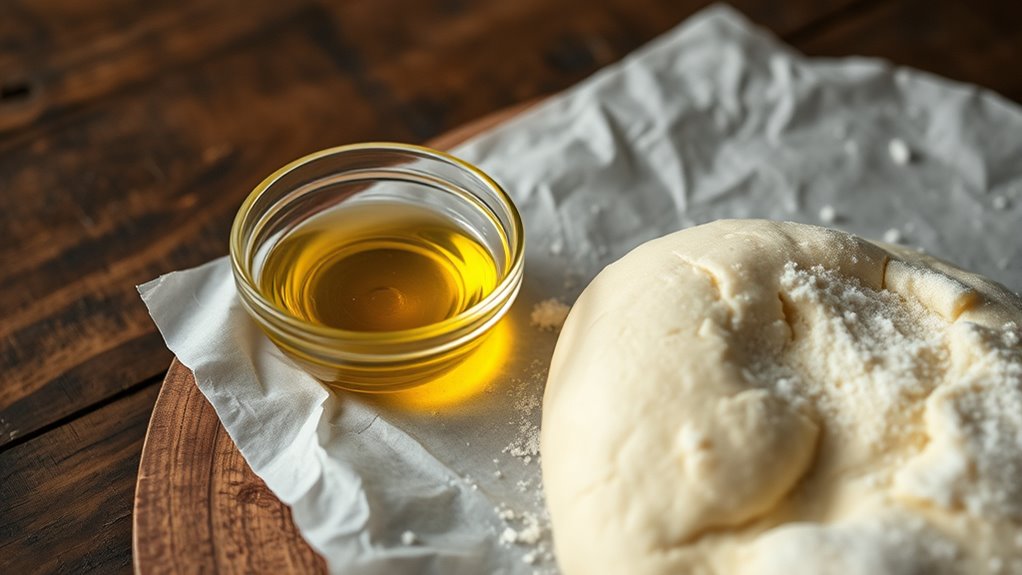
Oil and sugar considerably influence bacterial growth in dough, affecting its safety and shelf life. While sugar can promote fermentation and flavor enhancement, excessive amounts may encourage harmful bacteria, reducing safety. Oil acts as a barrier, slowing moisture loss and bacterial penetration, but can also create an environment for certain microbes if not managed properly. Understanding their effects helps you optimize nutritional value without risking spoilage.
- Sugar fuels yeast activity but can also support bacteria if overused
- Oil improves dough texture and flavor, but excessive oil may trap bacteria
- Proper balance maintains nutritional value and safety
- Controlling these ingredients helps prevent harmful bacterial proliferation while enhancing flavor
Adjusting Recipes for Better Safety and Longevity

Adjusting your recipes can considerably enhance both safety and shelf life by carefully balancing ingredients like sugar and oil. Increasing sugar adds sweetness and acts as a preservative, inhibiting microbial growth, which improves dough safety and preserves dough flavor. Incorporating the right amount of oil helps maintain moisture and prevents dryness, extending the dough’s freshness. Additionally, adjusting the baking temperature ensures thorough cooking, killing bacteria and molds that may develop during storage. Properly calibrated baking temperature also influences dough texture and flavor, making it more appealing and stable over time. By fine-tuning these factors, you not only improve safety but also achieve better dough flavor and longer-lasting results. Always test small batches when modifying ingredients to find the most suitable balance for your specific recipe.
Common Mistakes When Using Oil and Sugar in Dough

One common mistake is adding too much sugar, which can create a sticky dough that’s hard to work with and may lead to over-sweetening. Excess sugar can overpower other flavors and hinder proper color development during baking. Additionally, too much sugar can cause the dough to spread excessively, affecting texture. When using oil, overdoing it can result in greasy dough, reducing flavor enhancement and weakening structure. To avoid these pitfalls, keep these tips in mind:
Avoid overusing sugar and oil to ensure perfect dough texture and flavor balance.
- Measure sugar carefully to prevent over-sweetening
- Balance sugar with other flavor ingredients for maximum flavor enhancement
- Use oil sparingly to maintain dough structure and avoid greasiness
- Monitor baking to ensure proper color development without burning
Being precise helps you achieve better flavor, color, and overall dough quality.
Frequently Asked Questions
Can Gluten-Free Dough Containing Oil and Sugar Spoil Faster?
Yes, gluten-free dough with oil and sugar can spoil faster. The absence of gluten reduces stability, making it more prone to spoilage. Oil oxidation accelerates when exposed to air, causing rancidity, while sugar provides a medium for bacteria and mold growth. To extend freshness, store your dough in an airtight container in the fridge, and use it promptly to prevent spoilage caused by these factors.
Are There Alternative Ingredients That Improve Dough Safety?
Are there better ways to keep your dough safe? Absolutely. You can use natural preservatives like vinegar or lemon juice, which inhibit microbial growth, or choose alternative sweeteners like stevia or erythritol that don’t promote spoilage. These options help extend shelf life without relying on traditional sugars or oils. By incorporating these ingredients, you guarantee your dough stays fresh longer while maintaining a healthier profile.
How Does Ambient Temperature Affect Oil and Sugar in Dough?
Ambient temperature critically impacts oil and sugar in dough by influencing dough fermentation and microbial growth. When it’s warm, fermentation speeds up, which can cause overproofing and uneven texture. Higher temperatures also promote microbial growth, risking spoilage. Cooler environments slow fermentation, preserving dough quality and safety. To maintain ideal dough safety, control ambient temperatures, keeping them consistent to prevent unwanted microbial activity and ensure proper fermentation.
Is It Safe to Consume Dough After Extended Storage With Oil and Sugar?
You shouldn’t enjoy dough stored for too long with oil and sugar; it’s like opening a time capsule that may have gone bad. Fermentation risks increase, and mold can sprout like unwelcome weeds. After extended storage, harmful bacteria and mold can develop, making it unsafe to eat. Always check for a sour smell, discoloration, or visible mold before consuming, and when in doubt, discard to avoid health issues.
Do Different Types of Oils Influence Dough Safety Differently?
Different types of oils can influence dough safety because their stability varies; for example, oils with high saturated fat content tend to resist oxidation better, reducing spoilage risk. Meanwhile, sugar reactions, like caramelization or fermentation, may differ slightly with oil type, but overall, choosing stable oils like olive or coconut helps maintain dough quality longer. Always store dough properly to minimize bacteria growth, regardless of oil type.
Conclusion
By mastering mindful methods with oil and sugar, you protect your dough from spoilage and safeguard your sweets. Proper storage, careful adjustments, and keen observation keep your creations fresh and fabulous. Don’t let careless mistakes sabotage your baking bliss. Embrace excellence, avoid errors, and enjoy every bite with confidence. With thoughtful techniques, you’ll triumph over troubles, transforming simple ingredients into safe, sensational treats that truly satisfy!


